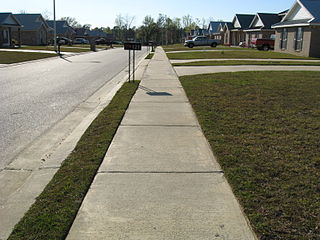Related Research Articles

Zoning is the process of dividing land in a municipality into zones in which certain land uses are permitted or prohibited. In addition, the sizes, bulk, and placement of buildings may be regulated. Zoning is the most common regulatory divider local governments use to help carry out urban plans. The type of zone determines whether planning permission for a given development is granted. Zoning may specify a variety of outright and conditional uses of land. It may also indicate the size and dimensions of land area as well as the form and scale of buildings. These guidelines are set in order to guide urban growth and development.
Regional planning deals with the efficient placement of land-use activities, infrastructure, and settlement growth across a larger area of land than an individual city or town. Regional planning is related to urban planning as it relates land use practices on a broader scale. It also includes formulating laws that will guide the efficient planning and management of such said regions. Regional planning can be comprehensive by covering various subjects, but it more often specifies a particular subject, which requires region-wide consideration.

Coconut Creek is a city in Broward County, Florida, United States. Situated 37 miles north of Miami, it had a population of 52,909 in 2010. It is part of the Miami-Fort Lauderdale-West Palm Beach, FL Metropolitan Statistical Area. The city seceded from Pompano Beach in the 1960s. It is nicknamed Butterfly Capital of the World, because it is home to the world's largest butterfly aviary, Butterfly World, with over 80 species and 5,000 individual butterflies.

Davie is a town in Broward County, Florida, United States about 24 miles north of Miami. The town′s population was 91,992 at the 2010 census. Davie is a principal city of the Miami metropolitan area, which was home to an estimated 6,012,331 people at the 2015 census. It is the most populous municipality labelled as a ″town" in Florida, and the fourth most populous such community in the United States, trailing only Hempstead, New York; Gilbert, Arizona; and Cary, North Carolina.

A residential area is a land used in which housing predominates, as opposed to industrial and commercial areas. Housing may vary significantly between, and through, residential areas. These include single-family housing, multi-family residential, or mobile homes. Zoning for residential use may permit some services or work opportunities or may totally exclude business and industry. It may permit high density land use or only permit low density uses. Residential zoning usually includes a smaller FAR than business, commercial or industrial/manufacturing zoning. The area may be large or small.
Land-use planning is the process of regulating the use of land in an effort to promote more desirable social and environmental outcomes as well as a more efficient use of resources. Goals of land use planning may include environmental conservation, restraint of urban sprawl, minimization of transport costs, prevention of land use conflicts, and a reduction in exposure to pollutants. By and large, the uses of land determine the diverse socioeconomic activities that occur in a specific area, the patterns of human behavior they produce, and their impact on the environment.
Village of Euclid, Ohio v. Ambler Realty Co., 272 U.S. 365 (1926), more commonly Euclid v. Ambler, was a United States Supreme Court landmark case argued in 1926. It was the first significant case regarding the relatively new practice of zoning, and served to substantially bolster zoning ordinances in towns nationwide in the United States and in other countries of the world including Canada.

Subdivision is the act of dividing land into pieces that are easier to sell or otherwise develop, usually via a plat. The former single piece as a whole is then known in the United States as a subdivision. Subdivisions may be simple, involving only a single seller and buyer, or complex, involving large tracts of land divided into many smaller parcels. If it is used for housing it is typically known as a housing subdivision or housing development, although some developers tend to call these areas communities.

A duplex house plan has two living units attached to each other, either next to each other as townhouses, condominiums or above each other like apartments. By contrast, a building comprising two attached units on two distinct properties is typically considered semi-detached or twin homes but is also called a duplex in parts of the Northeastern United States.

A setback, sometimes called step-back, is a step-like recession in a wall. Setbacks were initially used for structural reasons, but now are often mandated by land use codes, or are used for aesthetic reasons. In densely built-up areas, setbacks also help get more daylight and fresh air to the street level. Importantly, a setback helps lower the building's center of mass, making it more stable.

Mixed-use development is a term used for two related concepts:

In the law regulating historic districts in the United States, a contributing property or contributing resource is any building, object, or structure which adds to the historical integrity or architectural qualities that make the historic district, listed locally or federally, significant. Government agencies, at the state, national, and local level in the United States, have differing definitions of what constitutes a contributing property but there are common characteristics. Local laws often regulate the changes that can be made to contributing structures within designated historic districts. The first local ordinances dealing with the alteration of buildings within historic districts was in Charleston, South Carolina in 1931.

The 1916 Zoning Resolution in New York City was the first citywide zoning code in the United States. The zoning resolution reflected both borough and local interests, and was proposed after the bulky Equitable Building was erected in Lower Manhattan in 1915.

Zoning in the United States includes various land use laws falling under the police power rights of state governments and local governments to exercise authority over privately owned real property. The earliest zoning laws originated with the Los Angeles zoning ordinances of 1908 and the New York City Zoning resolution of 1916. Starting in the early 1920s, the United States Commerce Department drafted model zoning and planning ordinances in the 1920s to facilitate states in drafting enabling laws. Also in the early 1920s, a lawsuit challenged a local zoning ordinance in a suburb of Cleveland, which was eventually reviewed by the United States Supreme Court.
The American Commerce Center was a proposed supertall skyscraper approved for construction in Philadelphia, Pennsylvania but cancelled due to the 2008 recession. The Comcast Innovation and Technology Center now stands on the site.
A Planning and Zoning Commission is a local elected or appointed government board charged with recommending to the local town or city council the boundaries of the various original zoning districts and appropriate regulations to be enforced therein and any proposed amendments thereto. In addition, the Planning and Zoning Commission collects data and keeps itself informed as to the best practices generally in effect in the matter city planning and zoning. It may be qualified to act on measures affecting the present and future movement of traffic, the segregation of residential and business districts and the convenience and safety of persons and property in any way dependent on city planning and zoning.
Exclusionary zoning is the use of zoning ordinances in a manner which inadvertently excludes from certain zoning districts those persons protected by law from discrimination. As of the 2010s, zoning ordinances are standard in almost all communities, and occasionally these ordinances produce exclusionary zones. Exclusionary zoning was introduced in the early 1900s, typically to prevent racial and ethnic minorities from moving into middle- and upper-class neighborhoods. Municipalities seek to use zoning to safeguard the health, property, and public welfare by controlling the design, location, use or occupancy of all buildings and structures through the regulated and orderly development of land and land uses. This sometimes inadvertently limits the supply of available housing units, such as by prohibiting multi-family residential dwellings or setting minimum lot size requirements which may deter racial and economic integration.

The Town Planning Board is a statutory body of the Hong Kong Government tasked with developing urban plans with an aim to ensuring the "health, safety, convenience and general welfare of the community through the process of guiding and controlling the development and use of land, and to bring about a better organised, efficient and desirable place to live and work." It is founded upon section 2 of the Town Planning Ordinance.
In Australian rules football, zoning refers to a system whereby a given area, either region or lower-level football league, is reserved exclusively for one club.

The Torre de Manila(lit. 'Tower of Manila'; Filipino: Tore ng Maynila) is a high-rise residential building being built by DMCI Homes in Ermita, Manila, Philippines.
References
| This electronic music album-related article is a stub. You can help Wikipedia by expanding it. |